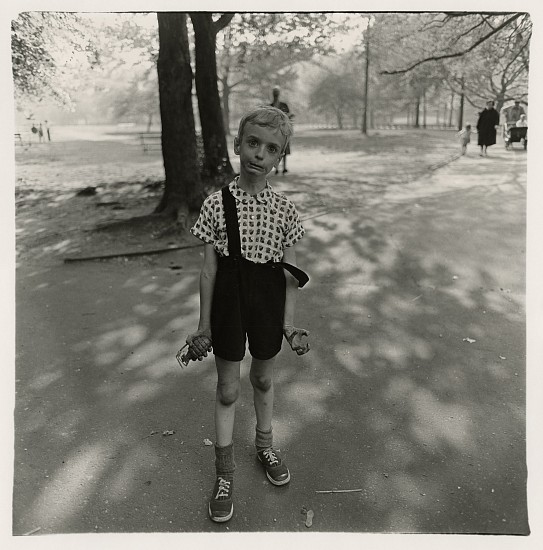Diane Arbus



Diane Arbus, Child with a Toy Hand Grenade in Central Park, N.Y.C., 1962
Gelatin silver print; printed later, 15 1/16 x 14 15/16 in. (38.3 x 37.9 cm)
Print by Neil Selkirk
Titled, dated, with "Neil Selkirk" and Doon Arbus's signature in ink within estate stamp along with Doon Arbus copyright stamp on print verso.
Illustrated: Arbus, Doon, and Marvin Israel, ed. Diane Arbus. Millerton: Aperture, 1972, no. 50. Phillips, Sandra et al. Diane Arbus: Revelations. New York: Random House/San Francisco Museum of Modern Art, 2003, p. 104-105. Rosenheim, Jeff L. Diane Arbus: in the beginning. New York: The Metropolitan Museum of Art, 2016, p. 257. Hermanson Meister, Sarah. Arbus, Friedlander, Winogrand: New Documents, 1967. New York: Museum of Modern Art, 2017, p. 62.
8523
Price Upon Request
Colin Wood, who is now 70 years old, was photographed by Diane Arbus in Central Park on the East Side, north of the 69th Street entrance and south of the 72nd Street entrance.
In an interview from 2005 with the Washington Post, Colin said, “…I think I was imitating a face I’d seen in war movies, which I loved watching at the time.”
“She catches me in a moment of exasperation. It's true, I was exasperated. My parents had divorced and there was a general feeling of loneliness, a sense of being abandoned. I was just exploding. She saw that and it's like . . . commiseration. She captured the loneliness of everyone. It's all people who want to connect but don't know how to connect. And I think that's how she felt about herself. She felt damaged and she hoped that by wallowing in that feeling, through photography, she could transcend herself.”
This image, titled as Exasperated Boy with Toy Hand Grenade was included in the landmark exhibition New Documents, curated by John Szarkowski at the Museum of Modern Art in 1967 and included work by Arbus, Lee Friedlander, and Garry Winogrand.
Szarkowski stated in the press release; “In the past decade, this new generation of photographers has redirected the technique and aesthetic of documentary photography to a more personal end. Their aim has not been to reform life but to know it, not to persuade but to understand. The world, in spite of its terrors, is approached as the ultimate source of wonder and fascination, no less precious for being irrational and incoherent…What is held in common is the belief that the world is worth looking at, and the courage to look at it without theorizing.”


